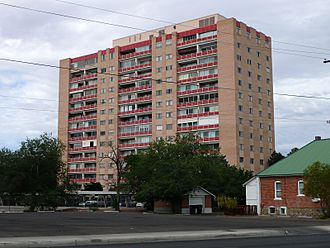Park Plaza Condominiums facts for kids
Quick facts for kids Park Plaza Condominiums |
|
|---|---|
 |
|
| General information | |
| Type | Residential |
| Location | 1331 Park Ave. SW Albuquerque, New Mexico, United States |
| Coordinates | 35°05′14.5″N 106°39′46″W / 35.087361°N 106.66278°W |
| Completed | 1964 |
| Opening | 1964 |
| Cost | $3 million |
| Height | |
| Roof | 160 ft (49 m) |
| Technical details | |
| Floor count | 14 |
| Design and construction | |
| Architect | William E. Burk, Jr. |
The Park Plaza Condominiums is a tall residential building in Albuquerque, New Mexico. Standing at 160 feet (49 m) high, it is one of the tallest buildings in the city. It is also the tallest building in New Mexico where people live. This 14-story tower was first built with apartments for rent. Later, in 1979, it was changed into condominiums, which means people could buy their own units. You can find it near Downtown Albuquerque, just west of Central Avenue.
Park Plaza was built between 1963 and 1964. It cost about $2.5 million to construct. When it first opened, it had 144 luxury apartments with one or two bedrooms. This made it the biggest apartment complex in Albuquerque at that time. Advertisements called it "the Southwest's most beautiful and modern apartment building." After it became condominiums, many owners updated their units. Some even combined smaller units to create bigger homes.
Contents
History of Park Plaza Condominiums
The Park Plaza Apartments began construction on May 14, 1963. It was a project by M.M. Hardin and partners Dan R. Ponder and C.H. Leavell. Workers started by building the two 165-foot (50 m) elevators. Then, they added the steel frame floor by floor. The building was finished in June 1964 and cost $3 million.
Design and Features of the Building
The building had a bold, modern design by architect William Burk, Jr. Its fancy Park Avenue address showed that Albuquerque was becoming a more modern city. It offered sophisticated city living, like in bigger cities. When it opened, there were 144 luxury apartments. They had one or two bedrooms and came in seven different layouts. Each apartment had its own balcony or "lanai," as the ads called it.
The apartments had modern appliances and central air conditioning. They also had garbage chutes and other handy features. Rent for these apartments ranged from $170 to $270. The ground floor also had shops, including a deli and a hair salon.
Changes Over the Years
At first, it was hard to find enough people to rent the apartments. One of the developers, Ponder, passed away in 1965. This caused problems for the project. The building ended up losing over $500,000. In 1966, the El Paso partners sold their shares to Hardin.
Eventually, the building became full. By 1967, over 80% of the apartments were rented. Over time, many renters changed their units to fit their needs. They could combine units, close off balconies, or make other changes. In 1979, Hardin sold the building to the Park Plaza homeowners association. They changed it into condominiums, where people could buy their own units.
By then, the apartments had many different layouts. The largest was a huge five-bedroom, five-bathroom unit called the Astoria. Park Plaza has continued to be a successful condominium building since then. In 2009, it had 130 units. Some were for sale, with prices from $140,000 to $265,000.
Why the Address is Unique
The address for Park Plaza is 1331 Park Avenue, SW. But if you look at the building, it's actually on 14th Street, SW. This might seem confusing!
How the Address Was Chosen
When the building was designed, the developer owned the land south of the building. This land went all the way to the corner of Park Avenue and 14th Street. Because of this, the building was given a Park Avenue address. The plan was to develop the empty land in front of it.
Why the Address Stayed the Same
Since then, that empty land has been sold. New condominiums have been built there. These new buildings now separate Park Plaza from Park Avenue. Even though the building is no longer directly on Park Avenue, its address was not changed. Officials decided that changing the address would cause problems for the people living there. So, the address has stayed the same ever since. This information comes from a letter written in 1981 by William H. Gooden, who was an assistant to the Mayor.

